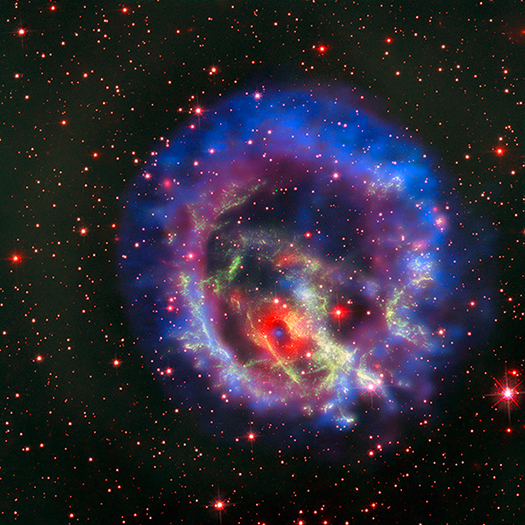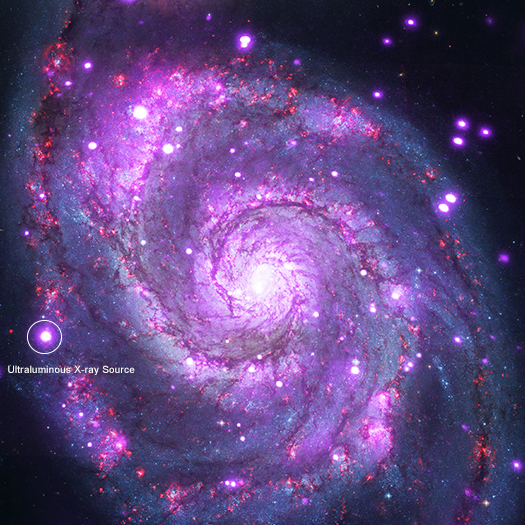Two Neutron Stars + Gravitational Waves = A Black Hole

Dave Pooley
It is a pleasure to welcome Dave Pooley as a guest blogger. Dave led the black hole study that is the subject of our latest press release. He is an associate professor at Trinity University in San Antonio, Texas, where he loves doing research with a cadre of amazing undergraduates on topics ranging from gravitational lensing to supermassive black holes to supernova explosions to exotic X-ray binaries to globular clusters. He lives in Austin with his wife, two (soon to be three) children, two cats, and one dog. When he’s not setting up train tracks, watching Daniel Tiger, or analyzing Chandra data, he enjoys cooking, woodworking, and all manner of whisky.
A colleague of mine at MIT once said that the minute the Laser Interferometer Gravitational Wave Observatory (LIGO) detects gravitational waves, it will be one of the most successful physics experiments ever performed, and the next minute, it will immediately become one of the most successful astronomical observatories ever operated.
He was exactly right. The direct detection of gravitational waves was a tremendous success for fundamental physics. We knew that gravitational radiation existed, but to directly detect it was huge. It was a triumph due to the meticulous and brilliant work of the hundreds of people who worked for years and years to make LIGO a success.
And immediately with that first detection, astronomers added gravitational waves to our tool belt of ways to study the universe. With just that first event, which was a merger of two black holes, we learned so much more about black holes than we previously knew. That, in turn, raised even more questions about these intriguing objects. Clearly, 60-solar-mass black holes exist. (That was news to us!) And you make them from 30-solar-mass black holes. (That was news to us too!) So 30-solar-mass black holes exist. (Even that was news to us, too!) But how do you make those? We astronomers have a few ideas, but we’re really not sure. We haven’t figured that out yet. Nature of course, already has.
Astronomers Spot a Distant and Lonely Neutron Star
Astronomers have discovered a special kind of neutron star for the first time outside of the Milky Way galaxy, using data from NASA's Chandra X-ray Observatory and the European Southern Observatory's Very Large Telescope (VLT) in Chile.
Neutron stars are the ultra dense cores of massive stars that collapse and undergo a supernova explosion. This newly identified neutron star is a rare variety that has both a low magnetic field and no stellar companion.
The neutron star is located within the remains of a supernova — known as 1E 0102.2-7219 (E0102 for short) — in the Small Magellanic Cloud, located 200,000 light years from Earth.
24 Hours of Light
Light is something we experience every day. For most people, "light" refers to what humans can detect with our eyes. It is illumination, what ignites our visual sense, the yin to the yang of dark. However, the type of light humans can detect with our eyes is just a small fraction that exists, and the true nature of light is much more expansive.
In many ways, light behaves like a wave and this is the key to understanding its amazing capabilities. How tightly packed — or far apart — the waves are dictates light's properties. For example, the longer the wave, the less energy the light typically carries, and vice versa. Each type of light has its own "super powers" both in their natural forms and in ways sculpted by science and technology.
Picture a piano keyboard. The popular definition of light would inhabit a few keys around middle C, while the rest of the piano represents the full breadth of light and its many forms. On one end of the piano of light, there are radio waves. As you move up through the octaves, there are other forms of light including microwaves, infrared, "visible" light, ultraviolet, X-rays, and gamma rays.
Sagittarius A* Swarm: Black Hole Bounty Captured in the Milky Way Center
In some ways, star clusters are like giant families with thousands of stellar siblings. These stars come from the same origins – a common cloud of gas and dust – and are bound to one another by gravity. Astronomers think that our Sun was born in a star cluster about 4.6 billion years ago that quickly dispersed.
Stellar Family Portrait in X-rays
In some ways, star clusters are like giant families with thousands of stellar siblings. These stars come from the same origins – a common cloud of gas and dust – and are bound to one another by gravity. Astronomers think that our Sun was born in a star cluster about 4.6 billion years ago that quickly dispersed.
By studying young star clusters, astronomers hope to learn more about how stars – including our Sun – are born. NGC 6231, located about 5,200 light years from Earth, is an ideal testbed for studying a stellar cluster at a critical stage of its evolution: not long after star formation has stopped.
The discovery of NGC 6231 is attributed to Giovanni Battista Hodierna, an Italian mathematician and priest who published observations of the cluster in 1654. Sky watchers today can find the star cluster to the southwest of the tail of the constellation Scorpius.
Black Girls Code and NASA's Chandra Team Up for a Special Event

On Saturday, April 14, women and girls will gather in Brooklyn, NY, for a special STEM (science, technology, engineering, and mathematics) event. Black Girls Code, or BGC, is partnering with NASA’s Chandra X-ray Observatory to help girls and young women learn how astronomers and computer scientists use data to create images of our Universe in two and three dimensions.
Following a connected series of activities, the participants (ages 9-13) will explore coding, 3D modeling, Virtual Reality, and more – all while using real data from NASA telescopes currently in space. Special guest speakers will include Andrea Razzaghi, Astrophysics Deputy Director at NASA HQ and Jessica Harris, an astronomer and education program development officer at the National Radio Astronomical Observatory.
This BGC event is the latest in the series of coding outreach programs developed by the Communications and Education group at the Chandra X-ray Center in Cambridge, Mass. The driving force for these efforts is Kimberly Arcand, who brings a computer science background to her role as Chandra’s Visualization lead, and her team of image processors, computer programmers and designers.
Chandra has consistently prioritized developing tools for non-experts to interact with and investigate data from Chandra, one of NASA’s “Great Observatories,” along with the Hubble Space Telescope and the Spitzer Space Telescope.
Perseus’s Cosmic Dance Helps Reveal the Secrets of Galaxy Cluster Astrophysics

Stephen A. Walker
We welcome Stephen A. Walker, first author on our latest results from the Perseus galaxy cluster, as our guest blogger. Originally from the UK, Stephen received his PhD at the University of Cambridge, continuing there as a postdoc, before becoming a NASA Postdoctoral Program Fellow at NASA’s Goddard Space Flight Center.
The story begins in October 2010, when I started my PhD at the University of Cambridge. I was exploring new X-ray observations of the outskirts of galaxy clusters taken with Suzaku. Much like in a city, the outskirts are where clusters continue to grow outwards.
Galaxy clusters are the largest gravitationally bound structures of the universe, consisting of hundreds or thousands of galaxies. The total masses of clusters are colossal, reaching up to and beyond a million billion times the mass of the sun. The vast majority of the ‘normal’ matter in these clusters (like hydrogen and helium) does not actually lie in the galaxies themselves, but rather in an extremely hot and diffuse gas between the galaxies, called the intracluster medium.
As the largest gravitationally bound structures in the universe, galaxy clusters continue to grow and accrete matter from the surrounding cosmic web of gas produced by the Big Bang. When the infalling gas falls into their deep gravitational potential wells, it is shock heated to tens of millions of degrees, and begins to emit prodigiously in the X-ray band.
A Cosmic Cold Front in the Perseus Cluster
A gigantic and resilient "cold front" hurtling through the Perseus galaxy cluster has been studied using data from NASA's Chandra X-ray Observatory. This cosmic weather system spans about two million light years and has been traveling for over 5 billion years, longer than the existence of our Solar System.
This graphic shows the cold front in the Perseus cluster. The image above contains X-ray data from Chandra — for regions close to the center of the cluster —along with data from ESA's XMM-Newton and the now-defunct German Roentgen (ROSAT) satellite for regions farther out. The Chandra data have been specially processed to brighten the contrast of edges to make subtle details more obvious.
A Crab Walks Through Time
Next year marks the 20th anniversary of NASA's Chandra X-ray Observatory launch into space. The Crab Nebula was one of the first objects that Chandra examined with its sharp X-ray vision, and it has been a frequent target of the telescope ever since.
There are many reasons that the Crab Nebula is such a well-studied object. For example, it is one of a handful of cases where there is strong historical evidence for when the star exploded. Having this definitive timeline helps astronomers understand the details of the explosion and its aftermath.
ULX in M51: Beaming with the Light of Millions of Suns
In the 1980s, scientists started discovering a new class of extremely bright sources of X-rays in galaxies. These sources were a surprise, as they were clearly located away from the supermassive black holes found in the center of galaxies. At first, researchers thought that many of these ultraluminous X-ray sources, or ULXs, were black holes containing masses between about a hundred and a hundred thousand times that of the sun. Later work has shown some of them may be stellar-mass black holes, containing up to a few tens of times the mass of the sun.
In 2014, observations with NASA's NuSTAR (Nuclear Spectroscopic Telescope Array) and Chandra X-ray Observatory showed that a few ULXs, which glow with X-ray light equal in luminosity to the total output at all wavelengths of millions of suns, are even less massive objects called neutron stars. These are the burnt-out cores of massive stars that exploded. Neutron stars typically contain only about 1.5 times the mass of the sun. Three such ULXs were identified as neutron stars in the last few years. Scientists discovered regular variations, or "pulsations," in the X-ray emission from ULXs, behavior that is exhibited by neutron stars but not black holes.
Now, researchers using data from NASA's Chandra X-ray Observatory have identified a fourth ULX as being a neutron star, and found new clues about how these objects can shine so brightly. The newly characterized ULX is located in the Whirlpool galaxy, also known as M51. This composite image of the Whirlpool contains X-rays from Chandra (purple) and optical data from the Hubble Space Telescope (red, green, and blue). The ULX is marked with a circle.






